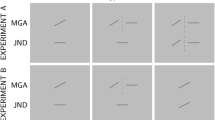Abstract
Earlier studies have suggested that the size of an object to be grasped influences the time taken to complete a prehensile movement. However, the use of cylindrical objects in those studies confounded the effects of object size — extent orthogonal to the reach axis — and object width — extent along the reach axis. In separating these effects, the present study demonstrates that movement time is not affected by manipulation of object size, as long as the latter does not approach the maximal object size that can be grasped. Object width, on the other hand, is shown to exert a systematic influence on movement time: Smaller object widths give rise to longer movement times through a lengthening of the deceleration phase of the movement, thus reproducing the effect of target width on the kinematics of aiming movements. As in aiming, movement amplitude also affects the movement time in prehension, influencing primarily the acceleration phase (i.e. peak velocity attained). The effects of object width and movement amplitude were found to combine in a way predicted by Fitts' law, allowing a generalisation of the latter to the transport component in prehensile actions. With respect to the grasp component, both object size and object width are shown to affect peak hand aperture. Increasing object width thus lowers the spatial accuracy demands on the transport component, permitting a faster movement to emerge. At the same time, the hand opens to a larger grip in order to compensate for eventual directional errors that result. Finally, with respect to the control mode of the grasp component, it was found that peak finger closing velocity scales to distance to be covered, defined as the peak hand aperture minus object size.
Similar content being viewed by others
References
Arbib MA (1981) Perceptual structures and distributed motor control. In: Brooks VB (ed) Motor control. (Handbook of physiology, vol II, part 2) Williams and Wilkins, Bethesda, pp 1449–1480
Arbib MA (1985) Schemas for the temporal organization of behavior. Hum Neurobiol 4:63–72
Athenes S (1992) Aspects de la coordination motrice à travers l'étude de la préhension et de la posture graphique. PhD thesis, Université d'Aix-Marseille II, France
Bootsma RJ, Van Wieringen PCW (1992) Spatio-temporal organisation of natural prehension. Hum Mov Sci 11:205–215
Chieffi S, Gentilucci M (1993) Coordination between the transport and the grasp components during prehension movements. Exp Brain Res 94:471–477
Fitts PM (1954) The information capacity of the human motor system in controlling the amplitude of movement. J Exp Psychol 47:381–391
Fitts PM, Peterson JR (1964) Information capacity of discrete motor responses. J Exp Psychol 67:103–112
Haggard P (1991) Task coordination in human prehension. J Mot Behav 23:25–37
Jagacinski RJ, Repperger DW, Moran MS, Ward SL, Glass B (1980) Fitts' law and the microstructure of rapid discrete movements. J Exp Psych Hum Percept 6:309–320
Jakobson LS, Goodale MA (1991) Factors affecting higher-order movement planning: a kinematic analysis of human prehension. Exp Brain Res 86:199–208
Jeannerod M (1981) Intersegmental coordination during reaching at natural visual objects. In: Long J, Baddeley A (eds) Attention and performance IX. Erlbaum, Hillsdale, NJ, pp 153–168
Jeannerod M (1984) The timing of natural prehension movements. J Mot Behav 16:235–254
Jeannerod M (1988) The neural and behavioural organization of goal-directed movements. Clarendon Press, Oxford
Kerr BA (1973) Movement time in an underwater environment. J Mot Behav 5:175–178
MacKenzie CL, Marteniuk RG, Dugas C, Liske D, Eickmeier B (1987) Three-dimensional movement trajectories in Fitts' task: implications for control. Q J Exp Psychol 39A:629–647
Marteniuk RG, MacKenzie CL, Jeannerod M, Athenes S, Dugas C (1987) Constraints on human arm movement trajectories. Can J Psychol 41:365–378
Marteniuk RG, Leavitt JL, MacKenzie CL, Athenes S (1990) Functional relationships between grasp and transport components in a prehension task. Hum Mov Sci 9:149–176
Meyer DE, Smith JEK, Wright CE (1982) Models for the speed and accuracy of aimed movements. Psychol Rev 89:449–482
Meyer DE, Abrams RA, Kornblum S, Wright CE, Smith JEK (1988) Optimality in human motor performance: ideal control of rapid aimed movements. Psychol Rev 95:340–370
Paulignan Y, MacKenzie C, Marteniuk R, Jeannerod M (1991a) Selective perturbation of visual input during prehension movements. I. The effects of changing object position. Exp Brain Res 83:502–512
Paulignan Y, Jeannerod M, MacKenzie C, Marteniuk R (1991b) Selective perturbations of visual input during prehension movements. II. The effects of changing object size. Exp Brain Res 87:407–420
Wade MG, Newell KM, Wallace SA (1978) Decision time and movement time as a function of response complexity in retarded persons. Am J Ment Def 83:135–144
Wallace SA, Weeks DL (1988) Temporal constraints in the control of prehensile movement. J Mot Behav 20:81–105
Wallace SA, Weeks DL, Kelso JAS (1990) Temporal constraints in reaching and grasping behaviour. Hum Mov Sci 9:69–93
Wing AM, Turton A, Fraser C (1986) Grasp size and accuracy of approach in reaching. J Mot Behav 18:245–260
Woodworth RS (1899) The accuracy of voluntary movement. Psychol Rev [Mon Suppl] 3 no. 3
Zaal FTJM, Bootsma RJ (1993) Accuracy demands in natural prehension. Hum Mov Sci 12:339–345
Author information
Authors and Affiliations
Rights and permissions
About this article
Cite this article
Bootsma, R.J., Marteniuk, R.G., MacKenzie, C.L. et al. The speed-accuracy trade-off in manual prehension: effects of movement amplitude, object size and object width on kinematic characteristics. Exp Brain Res 98, 535–541 (1994). https://doi.org/10.1007/BF00233990
Received:
Accepted:
Issue Date:
DOI: https://doi.org/10.1007/BF00233990




